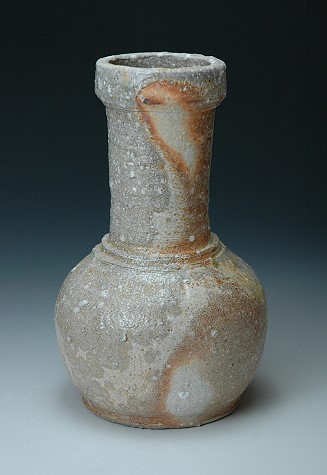
| Vasefinder Nationals 2009 |
| Exhibitor 74 |
 |
|
Hadi Abbas Orlando, Florida, USA Title: Ichiban Year of Creation: 2008 Glaze: Wood fired Clay Body: Stoneware Dimensions: Height 12 inches, Width 7 inches Artist's Statement: My roots are enriched with culture. I was born in Kerbala, Iraq to a Persian mother and an Indian father. In my early childhood, I lived in Gorgan, Iran, and in my later teen years moved to Blackburn, England for a year to study the English language. In addition, I am fluent in speaking Arabic, Persian and English. My artistic inspiration stems from a mechanical background and culturally diverse family unit. Much of my forms and designs are influenced by Persian, Indian, and Islamic architecture such as the domes on the Muslim's shrines and temples. Likewise, the ancient copper containers of Mesopotamia (present day Iraq), stone carved utensils of Persia, and American cast iron ware catapulted my efforts to design and build a device which allows me to intricately cut lids for my jars with precision. Lastly, the study of Ikebana (1999-2003), Japanese floral art, with master artist Mariko Haturi, has lead to the creative design on my vases and containers for my own masterpieces. My passion for working with clay, and imparting techniques and knowledge to others is founded on the theory of historical influence. Clay is more than throwing, glazing and firing. It possesses a mysterious energy that puts us in touch with our past. Clay reflects the maker's attitudes and spirit. Most of all, Clay is a natural material that exists nearby and around us. It is an overlooked resource that has great familiarity and yet people seldom take the opportunity to think much about it. That which covers the earth, and to that which we do return: Clay is the blanket of imagination and opportunity for the visionary artist. I often look for local clay when I travel to a new place and imagine what sort of work can be done with it. The implication of utility is an important aspect of my work. How was it used? How does it pour? What can be stored in it? Is it used for daily cooking, or for rituals and ceremonies? Whatever its use, working with clay is a form of self expression. It gives birth to courage and curiosity through forming, manipulating and firing. Ultimately, the discoveries unsheathed from working with clay exceed aesthetic beauty. They eject us beyond all our own inhibitions and unleash the intimacy and submission of our spirit into the material itself. Finally, the beauty of working with clay is that it makes its own demands and resists the efforts of the person who handles it. It manipulates and can be manipulated into the finest expression of history and heart. What is drawn out by using different kinds of clay varies due to the material's composition and character such as the smell, color, texture, softness or stiffness; clay forms are thus affected. No matter what occurs during the firing process, each viewer's perception will vary and beauty will emanate in different shades to all who appreciate its form. Nature is in your hand at the moment of creation. How this nature is given new life depends on the sensitivity of the maker. As the present fades and disappears, clay maintains its form forever. This sense of permanency creates a mysterious sense of human presence when looking at clay work and reminds us of our history, our lineage and our human evolvement. In summary, clay leads to a Contentment which is found through the processes of experimentation, examination, failure and discovery; the final product is a reflection of wonder. |
| To review detail photograph, click here. |
|
|
Vasefinder Home |